| Greek belongs to the
Indo-European languages. But unlike for example Latin which
developed into Italian, Spanish, French and partly English, the
Greek language has not spread beyond Greek territory.
|
| Among the earliest written
evidence from the Greek territory, is the famous Phaistos disc that supposedly
dates from the 17th century BC. The clay disc, with a diameter of 16 cm,
is stamped on both sides with the so-called Cretan hieroglyphs used in the
Early Palace Period (2000-1700 BC). The script has not yet been deciphered
so it is not known whether it is an early form of Greek.
|

|
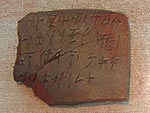 |
At the end of the period, Crete
was struck by several strong earthquakes which laid the old palaces in
ruins. But soon new and even more magnificent palaces were built to mark
the new age, the so-called Late Palace Period (1700-1450 BC). The writing
system, Linear A which has not
yet been deciphered either, dates from this period. |
| During the Post palatial Period
(1400-1100 BC) that developed after the destruction of the Minoan palaces
and cities, a third writing system Linear B, presumably developed from
Linear A, was used. When the British architect Michael Ventris, working
during World War II as a code expert, in 1953 deciphered Linear B, the
language proved to be an early form of Greek. As the same writing system
has also been found on the Greek mainland, it is theorized that entering Achaeans from Peloponnese (Mycenae)
brought the script to Crete.
|
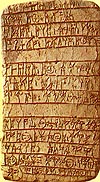
|
| The Post palatial Period ended
after an additional destruction, probably as a result of the Dorian
invasion from the Greek mainland. The new immigrants founded cities all
over Crete and brought with them new customs and traditions plus not least
a new language, the Doric dialect. Small groups of the original
inhabitants of the island, the Eteocretans, fled into the mountains, where
they for a longer period of time kept up their Minoan customs and language,
but gradually Crete became a part of the ancient Hellenic world.
|
| Among the earliest written
evidence from the Doric Crete, is the law inscription in Gortyna from the
early 5th century BC. It is written by turns from left to right and right
to left (boustrophedon). |

|
|
|
|
|
|
| In Antiquity the Greek language
consisted of several dialects, for example Doric, Aeolic and Ionic, but
from the 5th century the Ionic sub dialect "Attic" became the
predominant. Attic is the language, known today as Ancient Greek, as it
was spoken and written in Athens by for instance Plato,
Aristotle and Thucydides
during the city's great period in the middle of
the 5th century BC.
|
| Even after the Roman capture of
Greece in 146-86 BC, the Greek language did not die out. As a matter of
fact it continued to be so widespread that even children from the middle
classes in Rome had private lessons (often by a Greek slave). The New
Testament as well as many other early Christian manuscripts are written in
Koine (common Greek).
|
| When the Roman Empire was
divided in 395 AD, Greek became the official language of the Byzantine
Empire and the Orthodox Church, but the distance between the spoken and
the written language increased constantly as a revival of the ancient
Attic language was attempted.
|
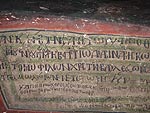
|
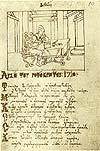 |
After the 4th crusade, Crete
was sold to Venice in 1204. At the end of the Venetian period, a
combination of Italian and Greek culture developed into the flourishing
Cretan renaissance, expressing itself in numerous poetic works and theatre
plays. The most famous work from that time is the Erotokritos of
Vitsentzos Kornaros (1553-1613) from Eastern Crete. |
|
|
|
|
|
| After the Ottoman capture of
first Constantinople (1453) and then the rest of the "Greek"
territory during the 15th-17th centuries (Crete 1669), the usage of the
Greek language continued actively in the local political management and
also in the church, as the Muslims allowed the Greek inhabitants to keep
their orthodox faith. The Greeks themselves called their language Roméika,
i.e. Roman.
|
| During the Ottoman hegemony, Greek adopted numerous Turkish loan words,
just like many Italian words had been adopted earlier during the Venetian
period.
|
| At the establishment of the new
Greek state in 1829, Modern Greek
was introduced as the official language. During the 19th and 20th century
there was a long conflict about which language was to be the official
language: The naturally developed common language (dimotiki ) or
the puristic written language (katharevousa). Katharevousa was an "artificial product", developed in
connection with the independence of Greece in an attempt to revive the
ancient Attic language. In reality the dispute was not settled until 1976,
two years after the fall of the junta, when the parliament passed an act
making Demotic the official language of Greece. This law is still
effective.
|
| The Greek language has in newer
time adopted quite a few loan words from English, and the Latin alphabet
is moreover being used more and more frequently in the new words. |
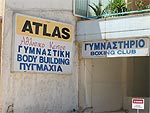
|
|
|
|
|
|
| Outside Greece itself, Greek is
spoken in Cyprus, by the Greeks in Istanbul and Alexandria and in a few
villages in Southern Italy. There are moreover large Greek minorities all
over the world where people still speak their old native language among
themselves.
|
| The Greek alphabet was
originally borrowed from
Phoenician in the 9th century
BC, but some of the symbols were phonetically modified into the lacking vowels, as were a few
consonants added. From Greek is derived as well the Latin alphabet as the
Cyrillic, which underlies the Russian alphabet.
|
|
|
|
|
|
|
|
|

